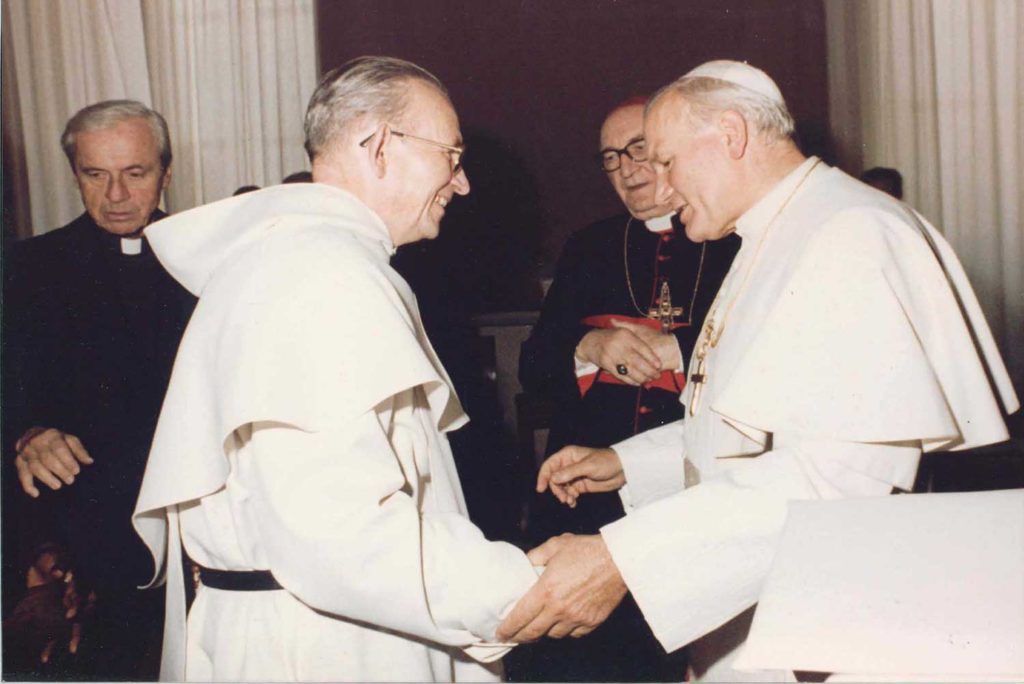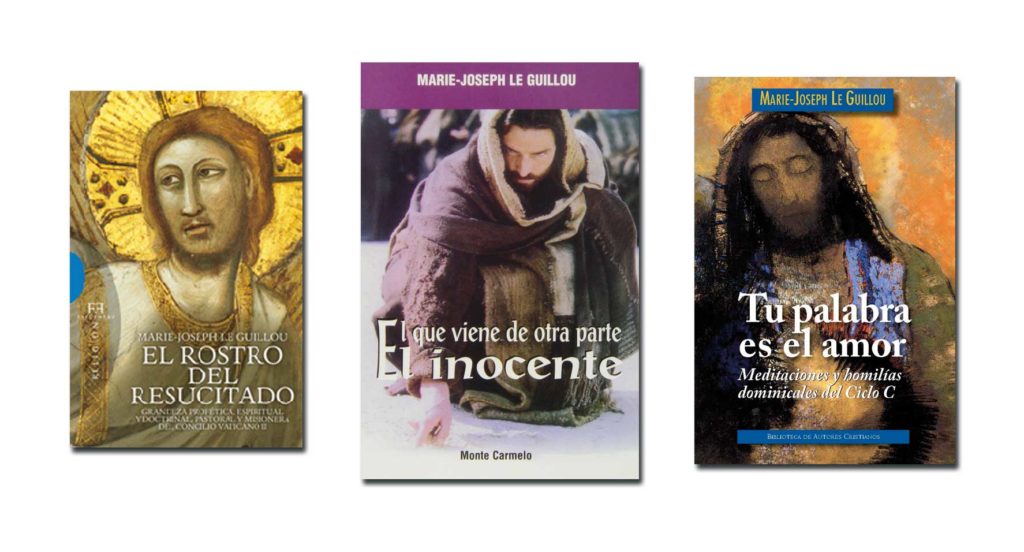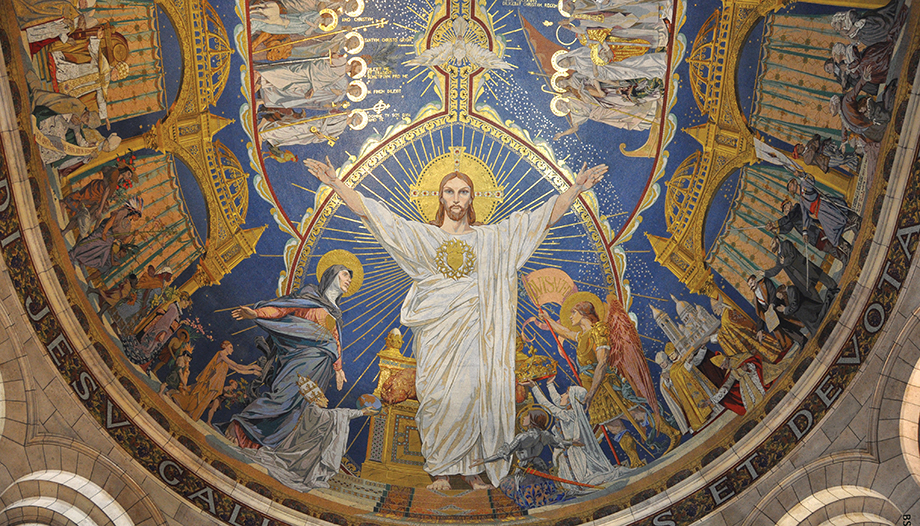Marcel Le Guillou was born on December 25, 1920 in Servel, a small village in Brittany (France), now part of the municipality of Lannion. His father was a non-commissioned officer in the navy (furriel) and his mother worked as a seamstress on the surrounding farms. He was a brilliant student (except in gymnastics), and won a scholarship for high school. When the family moved to Paris, he was able to enter the famous Lycée Henri IV and prepare himself for the École Normale Supérieurecenter, center top of the French education system. It is therefore the fruit of the merit award, which is one of the best things about the French Republic.
With the war and the German occupation (1939), he began to teach at the minor seminary in Lannion, where his younger brother was studying. It was there that his vocation took shape, which he attributes above all to the piety of his mother. He decided to become a Dominican. His father wanted him to finish his studies, and he obtained a degree in Classical Literature (grammar and philology). In 1941 he began to study theology at Le Saulchoir, the famous Dominican faculty in Paris. There he obtained a degree in philosophy in 1945 and in theology in 1949, and taught moral theology.
Vocation and ecumenical work
Since the first course at Le Saulchoir, he had attended along with Yves Congar to meetings with orthodox theologians and thinkers. He was very interested in it. For this reason, without leaving Le Saulchoir, he joined (1952) an institute that had been promoted by the Dominicans since 1920, and which was then renewed under the name of "Istina Center". The center is also renewing its journal on Russia and Christianity (Russia and Christianity) and gives it the same name (1954). Probably Istina is the best known Catholic journal on Eastern (Christian) theology and spirituality. Le Guillou collaborates with enthusiasm while preparing his doctoral thesis in theology, which will be, at the same time, on ecclesiology and ecumenism.
In the first part he studies the history of the ecumenical movement in the Protestant sphere, and the orthodox positions, up to the constitution of the Ecumenical Council of Churches. He is interested in the genesis of this effort and the theological nature of the problems that arose. In the second part, he studies the history of the divisions and confessional controversies up to the beginning of the dialogue. The Catholic Church has debated in order to preserve its identity, but it is also part of its identity and mission to try to reconcile divisions. It is necessary to study how the Church has understood itself in this sense in history. In this context, the notion of communion, which will be one of the keys to conciliar ecclesiology, stands out.
After the Council, the term "communion" will be the most widely used term to define the Church and as a way of summarizing what number 1 of Lumen Gentium: "The Church is in Christ, as a sacrament, that is, a sign and instrument of intimate union with God and of the unity of the whole human race.". But this was not the case at the time. This term, which has a canonical, theological and spiritual value, has come to the fore as a result of ecumenical dialogue. Le Guillou was one of those who contributed to its diffusion. He obtained his doctorate (1958) and his thesis was published in two volumes: Mission and unity. The demands of communion (1960).
From 1952, he taught oriental theology at Le Saulchoir, and in 1957 he spent several months on Mount Athos, an Orthodox monastic republic in Greece. There, he endears himself and contemplates Orthodoxy live. All this allowed him to publish a small book The Spirit of Greek and Russian Orthodoxy (1961) in an interesting collection of short essays (Encyclopedia of 20th Century Catholics), translated into Spanish by Casal i Vall (Andorra). The book, brief and accurate, pleased the orthodox theologians of Paris, who recognized themselves in it. It is still very useful (like other titles of that surprising "encyclopedia").
The theology of the mystery and the face of the Risen One
Le Guillou was struck on the one hand by the echoes of the liturgical and biblical theological renewal, and on the other by contact with Orthodoxy. This impelled him to develop a theology that better reflected the meaning of the mystery revealed in Scripture, celebrated in the Liturgy and lived by every Christian. He then undertook a great attempt at synthesis. Christ and the Church. Theology of the Mystery (1963), where, starting from St. Paul, he makes a long historical journey on the category of "mystery", to end with the mystery in St. Thomas Aquinas. True theology is not speculation, it is part of the Christian life.

These were exciting years. He follows with interest the development of the Second Vatican Council, and assists as an advisor to some bishops. He also gave numerous conferences. The work of synthesis he had just done on the Christian mystery allowed him to contemplate the theology of the Council with great unity, and he prepared an overall essay: The face of the Risen One (1968). The subtitle reflects what he thinks: Prophetic, spiritual and doctrinal, pastoral and missionary greatness of the Second Vatican Council. For Le Guillou, Christ is the face of God in the world; and the Church makes him present; making the face of Christ transparent is a challenge and a requirement for every Christian. Everything that the Council has said is inserted there.
Difficult years
However, something is not working. During the Council itself, he observes that there are those who appropriate it, invoking a "spirit of the Council" that will end up replacing the ecclesial experience and the letter of the Council itself. He also dislikes the interconfessional celebrations, where the identity of the liturgy received is not respected. He notes the strongly political and ideological tone of some. And with Olivier Clément (Orthodox theologian) and Juan Bosch (Dominican) he writes Gospel and revolution (1968).
The street and student "revolution" of '68 was followed by the ecclesiastical protest to the encyclical of Paul VI. Humanae vitaeand to the European theological dissent is added the Latin American revolutionary tendency. But the mystery of Christ is not that of a revolutionary but that of the "Suffering Servant": for this reason, with a certain poetic tone, he vindicates the figure of Christ in The innocent (Celui qui vient d'ailleurs, l'Innocent): the saving revolution of Christ is his death and resurrection. He relies on literary testimonies to show the intuitions of salvation (starting with Dostoevsky), and goes through Scripture to rescue the figure of a savior who has incarnated the enormous paradox of the beatitudes.
Theological urgencies
In 1969, Paul VI included him in the International Theological Commission that he had just created. This allowed him to converse with great friends (De Lubac), even if some of them surprised him (Rahner). It also obliged him to be aware of all the topics discussed. To him, who had reached a synthetic vision, it becomes clear that a transformation of the Christian mystery is breaking through. He sees it as a new gnosis, a profound ideological contamination.
He felt it especially when he was called to prepare the 1971 Synod of Bishops, dedicated to the priesthood. He worked tirelessly in the preparation of the documents, even to the point of health problems. He left convinced that it was necessary to counteract the new gnosis. He tried to start a magazine (Adventus) to serve as a counterweight to Conciliumto which he had also belonged, but he encountered resistance from the Germans (von Balthasar) and folded. Later, he had the generosity to join the French edition of the journal Communiopromoted among others by Von Balthasar.
Write an impassioned essay The mystery of the Father. Faith of the Apostles, Current Gnosis. (1973). There, on the one hand, he presents the Christian mystery as he had done in The InnocentOn the other hand, he discerns the ideological character of many deviations, especially those coming from Marxist contamination. In the face of hermeneutics that dissolve faith, he reaffirms the "hermeneutics of Christian witness" presented by the Fathers and Christian theologians (although he has little sympathy with the soteriology of St. Anselm). He is sure that he will scandalize, but he is rather shunned, because it is considered bad taste to mention that the situation is bad. All this is reflected in his diaries and notes, some of which are published (Flashes on the life of Father M.J. Le Guillou, 2000).
Spirituality
Without abdicating this titanic effort, he does not abandon the ordinary, which for him is preaching. Since he became a Dominican, he has been aware that his vocation is to preach. He mentions it many times in his notes. He gave numerous courses and began to minister to the Benedictine community of Sacre Coeur de Montmartre. Among other things, it is worth noting a complete cycle of preaching for the liturgical year (cycles A, B and C), which has also been translated into Spanish.
He understands that the strength of the Church is spirituality and that the situation cannot be fixed only on the doctrinal or disciplinary level. For this reason he writes The witnesses are among us. The experience of God in the Holy Spirit (1976), along the lines of the "hermeneutics of witness" of which he had spoken. He goes through Scripture to show that with the Holy Spirit the heart of the Father, his love and his truth, is opened to us: witnessed by the Apostles and martyrs and saints; experienced in the Church as a source of living water and the law of love and the impulse of charity and discernment of spirits. At times, this book is considered together with that of The Mystery of the Father y The innocent as a Trinitarian trilogy.
Last years
In 1974, when he was only 54 years old, he developed a degenerative disease (Parkinson's), less well known then than now, which gradually limited him. His relationship with the Benedictine Sisters of Sacre-Coeur, to whom he preached and wrote their constitutions, intensified. With the permission of his superiors, he finally retired to one of their houses (Prieuré of Béthanie). He is thus fortunate to have his archive and his documentation perfectly stored.
And an association of friends was created. With his help, it has been possible to publish posthumously many texts of spiritual character that he had kept. Professor Gabriel Richi, of the Faculty of Theology of San Damaso, has put this archive in order and has taken care of the recent Spanish edition of many of his works. To the prologues of those books and to others of his studies we have to thank for many of the data collected here.

- The face of the Risen One. 423 pages. Encounter, 2015. Le Guillou offers an example of the hermeneutic of renewal proposed by Benedict XVI.
- The innocent. 310 pages. Montecarmelo, 2005. Presents the mystery of Christ: his revolution is his death and resurrection.
- Your word is love. 232 pages. BAC 2015. Meditations and homilies for Circus C, taking the mystery of God as a starting point.








